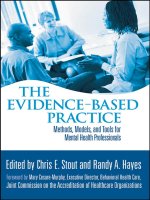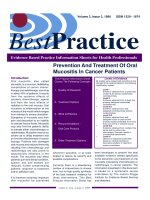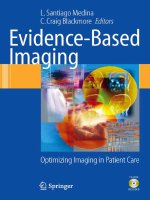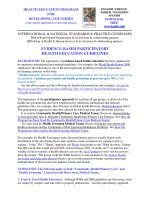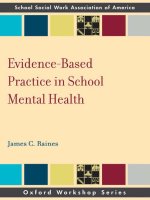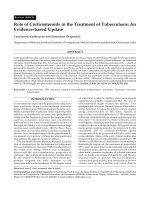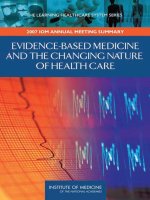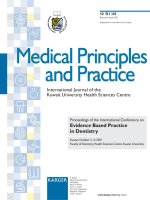Emergency treatment to SVT evidence based approach
Bạn đang xem bản rút gọn của tài liệu. Xem và tải ngay bản đầy đủ của tài liệu tại đây (1.26 MB, 28 trang )
Emergency treatment to SVT
Evidence-based Approach
Tran Thao Giang
Description
• ECG manifestations:
• HR is extremely rapid and regular (240bpm ± 40)
• P wave is:
• usually invisible
• When visible: anormal P axis, P precedes or follow QRS
Description
• SVT refers to tachydysrhythmias that require
• sinus nodal
• atrial
• AV (atrioventricular) nodal tissue,
• or a combination of these tissues for their commencement and
continuation.
• the term SVT refers to the following diagnoses:
• AV reentry tachycardia
• AV nodal reentry tachycardia
• unifocal atrial tachycardia
• multifocal atrial tachycardia
• sinoatrial reentry tachycardia
• and junctional tachycardia
Mechanism of AVNRT
Mechanism of AVRT
Pathologic causes
•
•
•
•
•
•
•
•
•
•
•
Pyrexia
Hypovolemia
Anemia
Axiety
Infection
Maglinancy
Miocardio ischemia
Congestive cardiac failure
Pulmonary embolus
Shock
Stimulants, prescriptions
Emergency evaluation
• Many infants tolerate SVT well
• SVT > 6-12hrs CO CHF
• Clinical of CHF :
• infants : irritability, tachypnea, poor feeding, pallor
• children : chest pain, palpitation, shortness of
breath, lightheadedness, fatigue
• Monitor rhythm during therapy to evaluate the
effect of interventions.
• The choice of therapy is determined by the
patient’s degree of hemodynamic instability.
• Attempt vagal stimulation first, unless the
patient is hemodynamically unstable or the
procedure will unduly delay chemical or electric
cardioversion (Class IIa, LOE C).
• In infants and young children, apply ice to the
face without occluding the airway.
• In older children, carotid sinus massage or
Valsalva maneuvers are safe.
• One method for performing a Valsalva maneuver
is to have the child blow through a narrow straw.
• Do not apply pressure to the eye because this
can damage the retina.
Pharmacologic cardioversion
• If IV/IO access is readily available, adenosine is the
drug of choice (Class I, LOE C).
• IV/IO adenosine 0.1 mg/kg with 2 syringes
connected to a T-connector
• Use a large vein for access
• give adenosine rapidly with 1 syringe and
immediately flush with 5 ml – 10ml of normal saline
with the other.
• Subsequent doses are increased by 0.1 mg/kg to a
maxi- mum of 0.3 mg/kg (maximum dose = 12 mg),
every 30sec if no effect on rhythm
Pharmacologic cardioversion
• An IV/IO dose of Verapamil, 0.1 to 0.3 mg/kg is
also effective in terminating SVT in older
children, but it should not be used in infants
without expert consultation (Class III, LOE C)
because it may cause potential myocardial
depression, hypotension, and cardiac arrest
Pharmacologic cardioversion
• If the patient is hemodynamically unstable or if
adenosine is ineffective, perform electric
synchronized cardioversion.
• Use sedation, if possible. Start with a dose of 0.5
to 1 J/kg. If unsuccessful, increase the dose to 2
J/kg (Class IIb, LOE C).
• If a second shock is unsuccessful or the
tachycardia recurs quickly, consider amiodarone
or procainamide before a third shock
Pharmacologic cardioversion
• amiodarone 5 mg/kg IO/IV or procainamide 15
mg/kg IO/IV for a patient with SVT unresponsive
to vagal maneuvers and adenosine and/or
electric cardioversion.
• for hemodynamically stable patients, expert
consultation is strongly recommended prior to
administration (Class IIb, LOE C)
Pharmacologic cardioversion
• Both amiodarone and procainamide must be
infused slowly (amiodarone over 20 to 60
minutes and procainamide over 30 to 60
minutes), depending on the urgency, while the
ECG and blood pressure are monitored. If there
is no effect and there are no signs of toxicity, give
additional doses.
• Avoid the simultaneous use of amiodarone and
procainamide without expert consultation.
• Ectopic SVT does not response to adenosine,
overdrive pacing, and electric cardioversion
• Prevention of recurrence of SVT
− In patients with: many times of recurrence,
severe manifestation during SVT (CHF, shock),
difficulties in termination of SVT
− Drugs: digoxin, propranolol or atenolol,
verapamil, amiodarone, sotalol.
